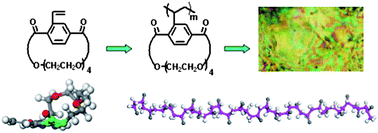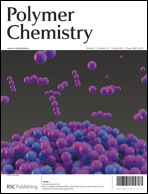Nonmesogenic cyclic oligoethylene oxide terephthalate is directly connected to flexible polyethylene main chain at every second carbon atom via the phenyl ring to obtain a novel vinyl polymer, poly(cyclic oligoethylene oxide vinylterephthalate) (PEOT-n), where n (= 4–6) denotes the number of ethylene oxide groups in the side chain. Although no traditional mesogenic unit is present in the repeating unit, one of the polymers, PEOT-4, displays a columnar nematic phase. Those containing 5 or 6 ethylene oxide groups are not liquid crystalline. Compared with its carbonic analogues, i.e., poly(alkylene vinylterephthalate) (PAVT-n), PEOT-n has a lower glass transition temperature and a smaller persistence length, which is due to the more flexible structure of ethylene oxide than that of carbonic chain. The strong steric interaction between cyclic pendants and the flexible main chain still exists, which causes PEOT-4 to take an extended-chain conformation, although the side ring in PEOT-n is less rigid. These polymers can complex with a number of positively charged groups or ions, similar to other systems containing ethylene oxide groups, and nevertheless, show different thermal behaviors.

You have access to this article
 Please wait while we load your content...
Something went wrong. Try again?
Please wait while we load your content...
Something went wrong. Try again?


 Please wait while we load your content...
Please wait while we load your content...